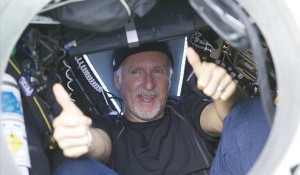James Cameron: Earth’s deepest place doesn’t look like ‘Avatar’

JOURNEY TO EARTH’S DEEPEST POINT Filmmaker James Cameron gives two thumbs-up as he emerges from the Deepsea Challenger submersible on Monday after his successful solo dive in the Mariana Trench. AP/NATIONAL GEOGRAPHIC
WASHINGTON—In James Cameron’s fantasy films, like “Avatar” and “The Abyss,” the unexplored is splashed in color and fraught with alien danger. But on his dive to the deepest place on Earth, reality proved far different: white, barren and bland.
Yet otherworldly—and amazing.
“My feeling was one of complete isolation from all of humanity,” Cameron on Monday said after returning from the cold, dark place in the western Pacific Ocean, 11 1/4 kilometers (7 miles) below the surface.
“More than anything, (it’s) realizing how tiny you are down in this big, vast, black, unknown and unexplored place … It was a very surreal day,” he added.
The only free-swimming creatures he saw near the bottom were tiny shrimp-like arthropods, but little else in the way of life was immediately visible.
35,576 feet
Better known as the director of such blockbuster films as “Titanic,” “Aliens” and “Avatar,” the 57-year-old Cameron made history as the first person to venture alone to the so-called Challenger Deep, the lowest-known point of the Earth’s crust, 10,843.5 meters (35,576 feet) beneath the ocean surface.
Cameron is the first person to explore the deepest valley in the ocean since two men made a 20-minute foray there more than half a century ago.
He spent about three hours gliding through the icy darkness, illuminated only by special lights on the one-man sub he helped design. That was only about half as long as planned because his battery ran low.
This deepest section of the 2,415-km-long Mariana Trench is so untouched that at first it appeared dull.
But there’s something oddly dark and compelling about the first snippets of video that Cameron shot.
It’s not what you see, but where it puts you. There is a sense of aloneness that Cameron conveys in the wordless video showing his sub gliding across what he calls “the very soft, almost gelatinous flat plain.”
Just being there
It may not have looked all that dramatic but there are still “dramatic discoveries to be made,” said Andy Bowen, who heads the deep submergence lab at Woods Hole Oceanographic Institution.
The minutelong snippet, released by trip sponsor National Geographic, is just a coming attraction.
Cameron will keep diving in the area, 320 km southwest of Guam, where the depth of the trench is called Challenger Deep. And he’s already filming it in 3D for later viewing.
To Cameron, the main thing was to appreciate just being there. He didn’t do that when he first dove to the wreck of the Titanic, and Apollo astronauts have said they never had time to savor where they were.
“There had to be a moment where I just stopped, and took it in, and said, ‘This is where I am; I’m at the bottom of the ocean, the deepest place on Earth. What does that mean?’” Cameron told reporters during a conference call.
“I just sat there looking out the window, looking at this barren, desolate lunar plain, appreciating,” Cameron said.
Chicken as bait
Cameron said he had hoped to see some sort of strange deep sea creature that would excite the storyteller in him, but he didn’t.
He didn’t see tracks of small primitive sea animals on the ocean floor, as he did when he dove 8 km down several weeks ago. All he saw was voracious shrimp-like critters no bigger than an inch (2.5 centimeters).
In future missions, Cameron plans to bring “bait”—like chicken—to set out.
He said the mission was all about exploration, science and discovery.
While Cameron’s dive was far longer than that of US Navy Captain Don Walsh and Swiss engineer Jacques Piccard 52 years ago, he didn’t reach the trench walls because he was running low on battery power.
Hydraulic failure
“This is the beginning of opening up this new frontier,” Cameron said. “To me, the story is in the people in their quest and curiosity and their attempt to understand.”
The trip to the deepest point took two hours and 36 minutes. His return aboard his 12-ton sub was a “faster-than-expected 70-minute ascent.”
The only thing that went wrong was a hydraulic failure that kept Cameron from collecting rocks and critters.
Science like this takes time, but Cameron is committed to doing it, said Bowen, who ran a program that sent an unmanned sub to the same place in 2009.
“The scientific process takes a significant amount of sweat, if you will, to uncover secrets,” Bowen said.
Cameron did sweat—and shiver.
When the 1.87-meter-tall Cameron climbed into the cramped sub, his head hit one end and his feet the other. It was warm outside because it was near the equator; it was toasty inside, temperatures topping 38 degrees Celsius, because of the heat given off by the sub’s electronics.
Real-world avatar
It felt “like a sauna,” he said.
But as he plunged into the deep, it grew cold inside the sub as the waters outside dropped to around 2 degrees Celsius.
Expedition physician Joe MacInnis called Cameron a real-world “avatar.”
“He’s down there on behalf of everybody else on this planet,” he said. ”There are 7 billion people who can’t go, and he can.” Reports from AP, New York Times News Service and Reuters